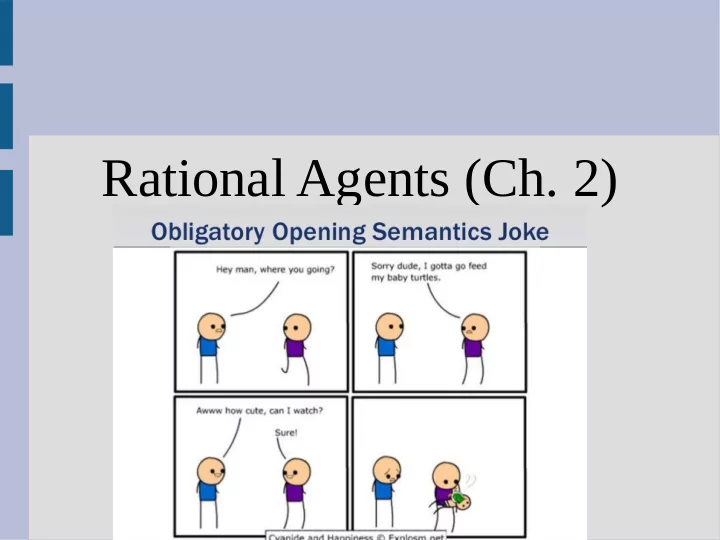

Rational Agents (Ch. 2)
Rational agent Remember vacuum problem? Agent program: if [Dirty], return [Suck] if at [room A], return [move right] if at [room B], return [move left]
Agent models Can also classify agents into four categories: 1. Simple reflex 2. Model-based reflex 3. Goal based 4. Utility based Top is typically simpler and harder to adapt to similar problems, while bottom is more general representations
Agent models 1. Simple reflex = “plans” a single move using only current information 2. Model-based reflex = “plans” a single move using current and (some) past information 3. Goal based = plans multiple moves (until goal) using current and past information 4. Utility based = “goals” have different values
Agent models What is the agent model of particles? Think of a way to improve the agent and describe what model it is now
Environment classification Environments can be further classified on the following characteristics:(right side harder) 1. Fully vs. partially observable 2. Single vs. multi-agent 3. Deterministic vs. stochastic 4. Episodic vs. sequential 5. Static vs. dynamic 6. Discrete vs. continuous 7. Known vs. unknown
Environment classification In a fully observable environment, agents can see every part. Agents can only see part of the environment if it is partially observable Full Partial
Environment classification If your agent is the only one, the environment is a single agent environment More than one is a multi-agent environment (possibly cooperative or competitive) single multi
Environment classification If your state+action has a known effect in the environment, it is deterministic If actions have a distribution (probability) of possible effects, it is stochastic deterministic stochastic
Environment classification An episodic environment is where the previous action does not effect the next observation (i.e. can be broken into independent events) If there is the next action depends on the previous, the environment is sequential episodic sequential
Environment classification If the environment only changes when you make an action, it is static a dynamic environment can change while your agent is thinking or observing dynamic static
Environment classification Discrete = separate/distinct (events) Continuous = fluid transition (between events) This classification can applies: agent's percept and actions, environment's time and states continuous (state) discrete (state)
Environment classification Known = agent's actions have known effects on the environment Unknown = the actions have an initially unknown effect on the environment (can learn) know how to stop do not know how to stop
Environment classification 1. Fully vs. partially observable = how much can you see? 2. Single vs. multi-agent = do you need to worry about others interacting? 3. Deterministic vs. stochastic = do you know (exactly) the outcomes of actions? 4. Episodic vs. sequential = do your past choices effect the future? 5. Static vs. dynamic = do you have time to think? 6. Discrete vs. continuous = are you restricted on where you can be? 7. Known vs. unknown = do you know the rules of the game?
Environment classification Some of these classifications are associated with the state, while others with the actions State: Actions: 1. Fully vs. partially observable 2. Single vs. multi-agent 3. Deterministic vs. stochastic 4. Episodic vs. sequential 5. Static vs. dynamic 6. Discrete vs. continuous 7. Known vs. unknown
Environment classification Pick a game/hobby/sport/pastime/whatever and describe both the PEAS and whether the environment/agent is: 1. Fully vs. partially observable 2. Single vs. multi-agent 3. Deterministic vs. stochastic 4. Episodic vs. sequential 5. Static vs. dynamic 6. Discrete vs. continuous 7. Known vs. unknown
Environment classification Agent Perfor Environ Actuator Sensors ment s type mance Particles time boarder, move screen- alive red balls mouse shot Fully observable, single agent, deterministic, sequential (halfway episodic), dynamic, continuous (time, state, action, and percept), known (to me!)
State structure An atomic state has no sub-parts and acts as a simple unique identifier An example is an elevator: Elevator = agent (actions = up/down) Floor = state In this example, when someone requests the elevator on floor 7, the only information the agent has is what floor it currently is on
State structure Another example of an atomic representation is simple path finding: If we start at Koffman, how would you get to Keller's CS office? Go E. -> Cross N @ Ford & Amundson -> Walk to E. KHKH -> K. Stairs -> CS office The words above hold no special meaning other than differentiating from each other
State structure A factored state has a fixed number of variables/attributes associated with it You can then reason on how these associated values change between states to solve problem Can always “un-factor” and enumerate all possibilities to go back to atomic states, but might be too exponential or lose efficiency
State structure Structured states simply describe objects and their relationship to others Suppose we have 3 blocks: A, B and C We could describe: A on top of B, C next to B A factored representation would have to enumerate all possible configurations of A, B and C to be as representative
State structure We will start using structured approaches when we deal with logic: Summer implies Warm Warm implies T-Shirt The current state might be: !Summer (¬Summer) but the states have intrinsic relations between each other (not just actions)
Recommend
More recommend